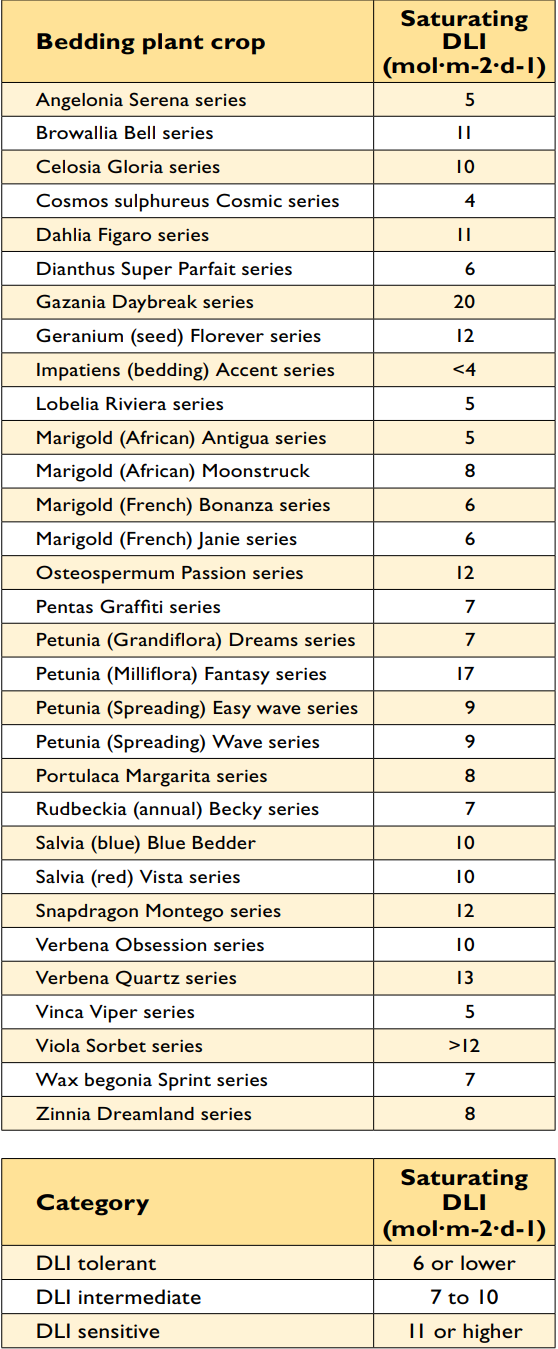
Saturating DLIs for flowering
DOWNLOADFebruary 15, 2011 - Erik Runkle and Matthew Blanchard
technically speaking By Erik Runkle and Matthew Blanchard
Saturating DLIs for Flowering

An increasing number of greenhouse growers are familiar with the term “daily light integral” or DLI, which quantifies the amount of photosynthetic light received during one day. The unit for DLI is mol∙m-2∙d-1, which is the number of particles of light (photons) that fall on a square meter per day. The maximum DLI received in greenhouses is around 25 to 30 mol·m-2·d-1, which can occur on a clear, late spring day, before whitewash is applied or retractable curtains are pulled. In contrast, DLIs as low as 2 mol·m-2·d-1 can be received in the winter on a dark, cloudy day in the Northern United States or Canada
DLI influences a number of growth and development parameters of floriculture crops, including rooting, branching, stem thickness, time to flower and flowering quality. Generally, when the DLI received by a crop averages less than 10 mol·m-2·d-1, light is considered to be a limiting factor for many species. However, since plants vary in their response to light, we determined the “saturating DLI” for flowering time for a number of bedding plants based on experiments performed at Michigan State University
Plants were grown under average DLIs from 3 to 20 mol·m2·d-1 by growing them at different times of the year, with or without shade cloths or supplemental lighting. The saturating DLI value was calculated as the DLI at which flowering was 95 percent of the maximal rate. In other words, a DLI above the saturating value had very little effect on flowering time. As the DLI decreased below the saturating DLI, flowering was progressively delayed. Based on these saturating DLI values, we can subjectively place crops into different DLI response categories:
- DLI-tolerant plants: those with a saturating DLI of 6 mol·m-2·d-1 or lower
- DLI-intermediate plants: those with a saturating DLI between 7 and 10 mol·m-2·d-1
- DLI-sensitive plants: those with a saturating DLI of 11 mol·m-2·d-1 or higher
These saturating DLI values are based solely on flowering time. Plant quality attributes, such as flower number or branching, will likely be greater when grown under DLIs higher than the saturating values.
There are several ways in which the saturating DLI values can be used. Flowering time of the DLI-tolerant plants would be impacted relatively little if grown in greenhouses that have low light transmission values, without supplemental lighting, and/ or under hanging baskets. For the most rapid flowering, DLIsensitive plants should be grown under the highest light conditions and could potentially benefit the most from supplemental lighting. For more information on DLI and guidelines for supplemental lighting, visit here.
Many of these bedding plants are also sensitive to the day length, or photoperiod. Therefore, for the most rapid flowering, long days accelerate flowering of long-day plants such as ageratum, blue lobelia, blue salvia, dianthus, gazania, pansy, petunia, rudbeckia, snapdragon, verbena and viola. Celosia, cosmos, dahlia and African marigold flower faster under short days. Thus, supplemental lighting during the night may be of limited value for these short-day plants since any acceleration of flowering from a higher DLI could be offset by a delay in flowering from long days.
Erik Runkle is associate professor and floriculture extension specialist in Michigan State University’s department of horticulture. He can be reached at runkleer@msu.edu or 517.355.5191 ext. 1350.



 Print
Print Email
Email





